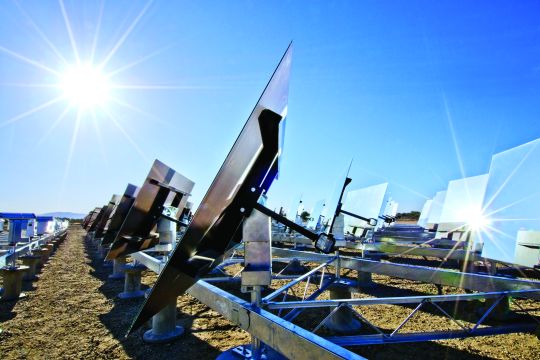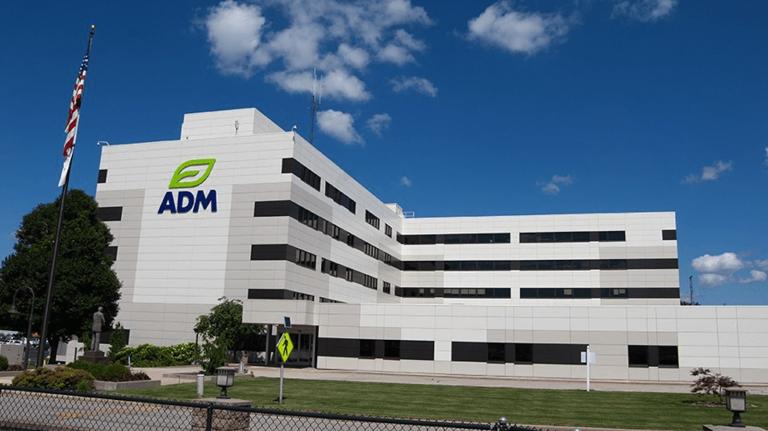In the transition to a clean, green economy, one milestone promises to be the most symbolically powerful. It’s the one adopted as an official target by Google: renewable energy cheaper than coal, or RE<C. When it announced its campaign, Google also announced the recipients of its initial investments.
One was eSolar, a Pasadena, Calif.-based company spun off from business incubator Idealab. “Our view of what it takes to make solar power viable and a widespread technology,” says Robert Rogan, eSolar’s executive VP of corporate development, “is to be able to compete with fossil fuel energy prices in an unsubsidized way.” Cheaper than coal per-kwh, without subsidies, by 2012: that’s the aspiration.
How will they do it? The company has designed a new kind of utility-scale solar power plant. Solar thermal plants are huge arrays of mirrors that harness the sun’s heat to drive steam turbines and create electricity. New solar thermal companies are thick on the ground in the California desert, but eSolar claims some distinct advantages.
eSolar’s plants are designed to overcome some of the primary hurdles facing the solar sector, namely price, speed, and scalability. The core strategy is, as the company puts it, to replace “expensive steel, concrete, and brute force with inexpensive computing power and elegant algorithms.” Rather than large, complex heliostats that must be precision-engineered on site by specialized laborers and equipment, they designed heliostats made of small, simple, prefabricated parts that can be cheaply shipped and quickly assembled, with minimal skilled labor. (Think Ikea.)
Because the heliostats are low to the ground, using lots of small, flat mirrors rather than a few large parabolic mirrors, they require far less steel and concrete to anchor them. Solar thermal heliostats can be up to 100 square meters, but eSolar’s “are closer to a square meter,” Rogan says. “They’re really human-sized.”
Efficiency is maximized by a computerized tracking system, with sensors and semiconductors doing the work bulk once did. (As Idealab’s Bill Gross said at the Fortune conference, computing power is the one commodity that’s getting cheaper.)
So eSolar boasts cheap capital and labor costs, but perhaps the most interesting angle is modularity. The plants are built in 33MW units that cover 160 acres each (1/4 of a square mile). This gives eSolar access to smaller, cheaper, more marginal sites, allowing them to fit plants near existing transmission rather than requiring new lines. “This is more distributed than your typical central station power plant,” says Rogan. “Given any large load center, it’s possible to build multiple modules at different interconnection points around that load center, as opposed to one single very large facility at one grid interconnected point.” The company says it’s already secured the rights to enough land to produce 1GW.
eSolar may be at the center of a hype storm, but it isn’t pie in the sky. It announced $130 million in funding from Google and others earlier this year, and just last week it announced its first power purchase agreement (PPA), a deal with Southern California Edison for 245MW, coming online in 2011.
Solar thermal is almost certainly going to be a huge player in 21st century energy, and one or two of the companies springing up now will make the transition to serious multinational scale. Time will tell whether eSolar is an eToys (a previous Idealab venture) or an eBay, but if buzz and investor enthusiasm are any guide, the future looks pretty bright.
Leftovers:
Is eSolar looking into storage? “Our technology is capable of employing thermal storage,” says Rogan. “We aren’t discussing our specific storage plans at this time. We’re open to all options.” Could units smaller than 33MW conceivably be built using this technology? “Because we still need power plant equipment such as a turbine, at some point those economics become challenging, the smaller you get.” Will eSolar be lobbying Calif. state gov’t for better solar policy? “I couldn’t speculate on that.” Is there more to the Google partnership than funding? “Google made a corporate investment in eSolar.” Will they buy some eSolar power? “I can’t comment on anything else with regard to Google. They made a corporate investment … You are asking the good questions.” [eyebrow raise] A price on carbon isn’t exactly a “subsidy” for solar power — when you say you’ll break even with coal without subsidies, are you assuming a carbon price? “Our goal is to be competitive without subsidies in the future.” OK then. Are you shopping your technology around internationally? “We’re considering projects all over the place.” Do you plan on staying in the U.S. despite more favorable policy environment abroad? “We’re definitely planning on building a lot of power projects in the U.S.”



